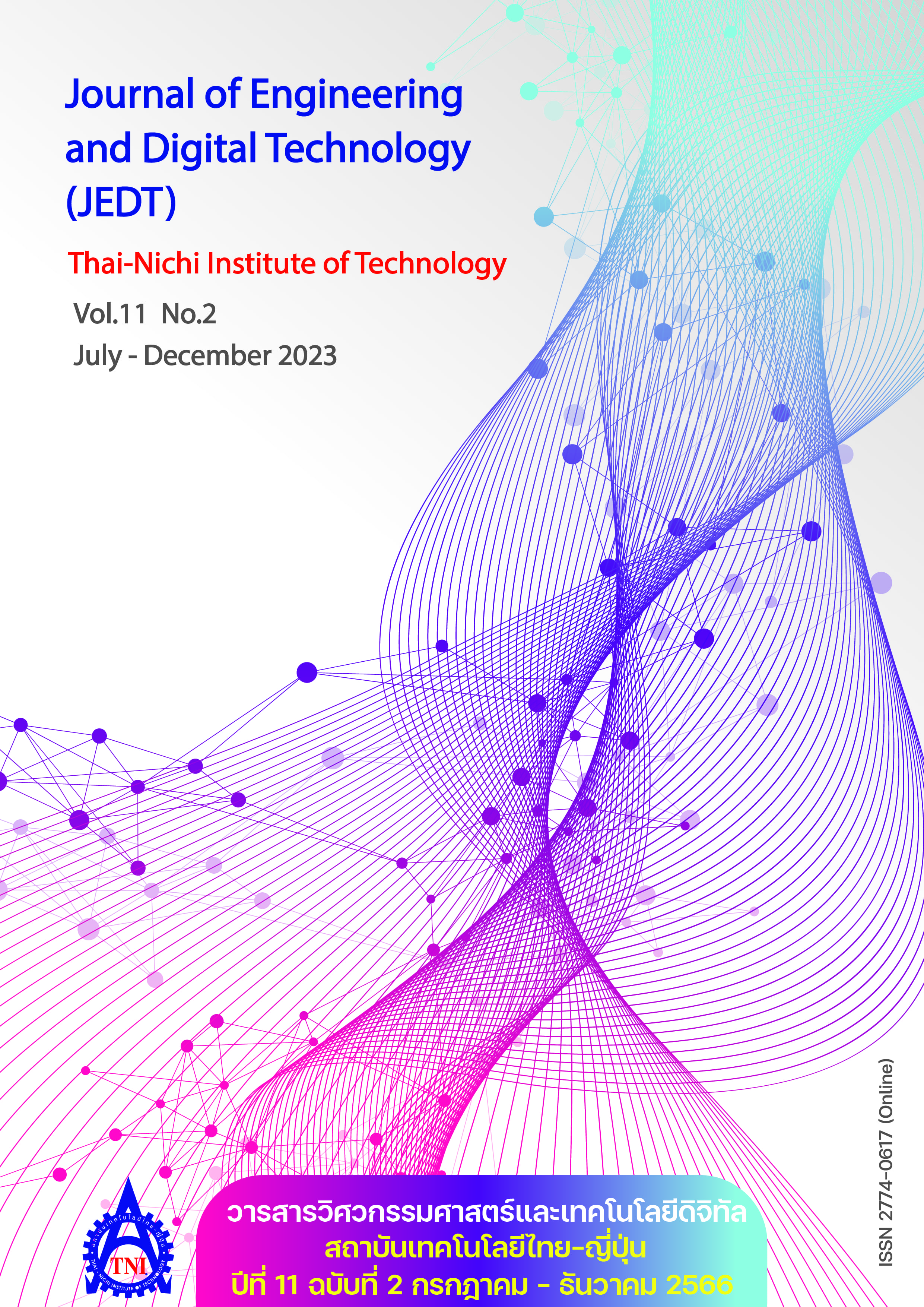การวิเคราะห์รูปแบบการสัญจรด้วยเท้าของธุรกิจในเขตวัฒนาในช่วงการระบาดของโรคโควิด-19
Main Article Content
บทคัดย่อ
ในปี ค.ศ. 2020–2022 ประเทศไทยมีผู้ติดเชื้อและเสียชีวิตจำนวนมากจากการแพร่ระบาดของโควิด-19 การประกาศใช้มาตรการเพื่อควบคุมสถานการณ์การแพร่ระบาดส่งผลให้หลายธุรกิจขาดทุนสะสมและปิดกิจการ จึงมีความจำเป็นอย่างยิ่งที่จะต้องศึกษาผลกระทบที่เกิดขึ้นเพื่อรับมือสถานการณ์โรคระบาดในอนาคต ข้อมูลการสัญจรด้วยเท้าที่ใช้ในงานวิจัยนี้ได้จากการติดตามตำแหน่งโทรศัพท์เคลื่อนที่แบบไม่เปิดเผยข้อมูลส่วนบุคคล โดยใช้ระบบดาวเทียมช่วยระบุตำแหน่งบนพื้นโลกเพื่อวิเคราะห์ผลกระทบธุรกิจในเขตวัฒนา จังหวัดกรุงเทพฯ โดยเป้าหมายของงานวิจัย คือ ศึกษาและเปรียบเทียบความเหมือน-ต่างของรูปแบบการสัญจรด้วยเท้าของธุรกิจแต่ละประเภท โดยจัดกลุ่มขนาดสถานที่ตามจำนวนการสัญจรด้วยเท้าเฉลี่ยต่อวันแล้วเปรียบเทียบด้วยเงื่อนไขความแตกต่างระหว่างอัตราส่วนค่าเฉลี่ยการสัญจรด้วยเท้าของกลุ่มและสถานที่, วิเคราะห์ผลกระทบประกาศมาตรการจากรัฐบาลต่อปริมาณการสัญจรด้วยเท้า และวิเคราะห์การฟื้นตัวธุรกิจ โดยการเปรียบเทียบความแตกต่างปริมาณการสัญจรด้วยเท้าด้วยสถิติทดสอบ Kolmogorov-Smirnov และ Wilcoxon Signed-Rank จากงานวิจัยนี้พบว่าธุรกิจแต่ละประเภทมีรูปแบบการสัญจรด้วยเท้าที่เป็นเอกลักษณ์และสัมพันธ์กับจำนวนการสัญจรด้วยเท้าเฉลี่ยต่อวัน ผลการเปรียบเทียบสถานที่ตัวอย่างที่ผ่านเงื่อนไขต่อสถานที่ตัวอย่างทั้งหมดของธุรกิจบาร์และสถานบันเทิง 130/204, ธุรกิจศูนย์การแพทย์และโรงพยาบาล 143/204, ธุรกิจอาคารสำนักงาน 199/282, ธุรกิจร้านอาหาร 304/480 และธุรกิจร้านค้าปลีกและห้างสรรพสินค้า 145/180 การประกาศใช้พระราชกำหนดการบริหารราชการในสถานการณ์ฉุกเฉิน (พ.ร.ก.ฉุกเฉิน), เคอร์ฟิว และห้ามนักท่องเที่ยวต่างชาติเดินทางเข้าประเทศไทย ส่งผลให้จำนวนการสัญจรด้วยเท้าลดลงและคงที่อยู่ในระดับต่ำที่สุดในช่วงระยะเวลาที่ศึกษา การสั่งปิดธุรกิจบาร์และสถานบันเทิงครั้งที่ 2 ใช้เวลาถึงสองเดือนเพื่อควบคุมจำนวนการสัญจรด้วยเท้าให้อยู่ในระดับต่ำ โดยระหว่างที่ประกาศใช้มาตรการนี้มีบางช่วงเวลาที่จำนวนการสัญจรด้วยเท้าเพิ่มขึ้นซึ่งสวนทางกับจุดประสงค์ของมาตรการ และจากสถิติทดสอบพบว่าในเดือนตุลาคม ค.ศ. 2022 ไม่มีธุรกิจประเภทใดฟื้นตัวเมื่อเทียบกับช่วงก่อนเกิดการแพร่ระบาดโควิด-19
Article Details

อนุญาตภายใต้เงื่อนไข Creative Commons Attribution-NonCommercial-NoDerivatives 4.0 International License.
นโยบายการรับบทความ
กองบรรณาธิการวารสารสถาบันเทคโนโลยีไทย-ญี่ปุ่น มีความยินดีรับบทความจากอาจารย์ประจำ และผู้ทรงคุณวุฒิในสาขาวิศวกรรมศาสตร์และเทคโนโลยี ที่เขียนเป็นภาษาไทยหรือภาษาอังกฤษ ซึ่งผลงานวิชาการที่ส่งมาขอตีพิมพ์ต้องไม่เคยเผยแพร่ในสิ่งพิมพ์อื่นใดมาก่อน และต้องไม่อยู่ในระหว่างการพิจารณาของวารสารอื่นที่นำส่ง ดังนั้นผู้สนใจที่จะร่วมเผยแพร่ผลงานและความรู้ที่ศึกษามาสามารถนำส่งบทความได้ที่กองบรรณาธิการเพื่อเสนอต่อคณะกรรมการกลั่นกรองบทความพิจารณาจัดพิมพ์ในวารสารต่อไป ทั้งนี้บทความที่สามารถเผยแพร่ได้ประกอบด้วยบทความวิจัย ผู้สนใจสามารถศึกษาและจัดเตรียมบทความจากคำแนะนำสำหรับผู้เขียนบทความ
การละเมิดลิขสิทธิ์ถือเป็นความรับผิดชอบของผู้ส่งบทความโดยตรง บทความที่ได้รับการตีพิมพ์ต้องผ่านการพิจารณากลั่นกรองคุณภาพจากผู้ทรงคุณวุฒิและได้รับความเห็นชอบจากกองบรรณาธิการ
ข้อความที่ปรากฏภายในบทความของแต่ละบทความที่ตีพิมพ์ในวารสารวิชาการเล่มนี้ เป็น ความคิดเห็นส่วนตัวของผู้เขียนแต่ละท่าน ไม่เกี่ยวข้องกับสถาบันเทคโนโลยีไทย-ญี่ปุ่น และคณาจารย์ท่านอื่น ๆ ในสถาบัน แต่อย่างใด ความรับผิดชอบด้านเนื้อหาและการตรวจร่างบทความแต่ละบทความเป็นของผู้เขียนแต่ละท่าน หากมีความผิดพลาดใด ๆ ผู้เขียนแต่ละท่านจะต้องรับผิดชอบบทความของตนเองแต่ผู้เดียว
กองบรรณาธิการขอสงวนสิทธิ์มิให้นำเนื้อหา ทัศนะ หรือข้อคิดเห็นใด ๆ ของบทความในวารสารสถาบันเทคโนโลยีไทย-ญี่ปุ่น ไปเผยแพร่ก่อนได้รับอนุญาตจากผู้นิพนธ์ อย่างเป็นลายลักษณ์อักษร ผลงานที่ได้รับการตีพิมพ์ถือเป็นลิขสิทธิ์ของวารสารสถาบันเทคโนโลยีไทย-ญี่ปุ่น
ผู้ประสงค์จะส่งบทความเพื่อตีพิมพ์ในวารสารวิชาการ สถาบันเทคโนโลยีไทย-ญี่ปุ่น สามารถส่ง Online ที่ https://www.tci-thaijo.org/index.php/TNIJournal/ โปรดสมัครสมาชิก (Register) โดยกรอกรายละเอียดให้ครบถ้วนหากต้องการสอบถามข้อมูลเพิ่มเติมที่
- กองบรรณาธิการ วารสารสถาบันเทคโนโลยีไทย-ญี่ปุ่น
- ฝ่ายวิจัยและนวัตกรรม สถาบันเทคโนโลยีไทย-ญี่ปุ่น
เลขที่ 1771/1 สถาบันเทคโนโลยีไทย-ญี่ปุ่น ซอยพัฒนาการ 37-39 ถนนพัฒนาการ แขวงสวนหลวง เขตสวนหลวง กรุงเทพมหานคร 10250 ติดต่อกับคุณพิมพ์รต พิพัฒนกุล (02) 763-2752 , คุณจุฑามาศ ประสพสันติ์ (02) 763-2600 Ext. 2402 Fax. (02) 763-2754 หรือ E-mail: JEDT@tni.ac.th
เอกสารอ้างอิง
X. Wang, J. Liono, W. Mcintosh, and F. D. Salim, “Predicting the city foot traffic with pedestrian sensor data,” in Proc. 14th EAI Int. Conf. Mobile and Ubiquitous Syst.: Comput., Netw. and Services, Melbourne, Australia, 2017, pp. 1–10.
T. Chao, R. Du, J. Gluck, H. Maidasani, K. Wills, and B. Shneiderman, “C-flow: visualizing foot traffic and profit data to make informative decisions,” Dept. Comput. Sci., Univ. Maryland, College Park, MD, USA, 2013. [Online]. Available: https://www.researchgate.net/publication/340935443_C-Flow_Visualizing_Foot_Traffic_and_Profit_Data_to_Make_Informative_Decisions
W. J. Ladeira, F. de Oliveira Santini, and D. C. Pinto, “Clockwise versus counterclockwise turning bias: Moderation effects of foot traffic and cognitive experience on visual attention,” J. Retailing Consumer Services, vol. 67, 2022, Art. no. 102965.
G. Alizo, A. Onayemi, J. D. Sciarretta, and J. M. Davis, “Operating room foot traffic: A risk factor for surgical site infections,” Surgical Infections, vol. 20, no. 2, pp. 146–150, 2019.
J. Barthélemy, N. Verstaevel, H. Forehead, and P. Perez, “Edge-computing video analytics for real-time traffic monitoring in a smart city,” Sensors, vol. 19, no. 9, p. 2048, 2019.
A. Sevtsuk, R. Basu, and B. Chancey, “We shape our buildings, but do they then shape us? A longitudinal analysis of pedestrian flows and development activity in Melbourne,” PloS one, vol. 16, no. 9, 2021, Art. no. e0257534.
S. Hasan and S. V. Ukkusuri, “Urban activity pattern classification using topic models from online geo-location data,” Transp. Res. Part C: Emerging Technol., vol. 44, pp. 363–381, 2014.
J. C. Herrera, D. B. Work, R. Herring, X. J. Ban, Q. Jacobson, and A. M. Bayen, “Evaluation of traffic data obtained via GPS-enabled mobile phones: The mobile century field experiment,” Transp. Res. Part C: Emerg. Technol., vol. 18, no. 4, pp. 568–583, 2010.
S. Abrishami, P. Kumar, and W. Nienaber, “Smart stores: A scalable foot traffic collection and prediction system,” in Proc. 17th Indus. Conf. Data Mining (ICDM 2017), Leipzig, Germany, Jul. 2017, pp. 107–121.
F. Zheng and Q. Liu, “Anomalous telecom customer behavior detection and clustering analysis based on ISP’s operating data,” IEEE Access, vol. 8, pp. 42734–42748, 2020.
J. Roetman, “Using WiFi Signals in Combination with GPS to Track Human Traffic in a Space,” EasyChair, no. 3902, 2020. [Online]. Available: https://easychair.org/publications/preprint/vzfQ
V. Romero, W. D. Stone, and J. D. Ford, “COVID-19 indoor exposure levels: An analysis of foot traffic scenarios within an academic building,” Transp. Res. Interdisciplinary Perspectives, vol. 7, 2020, Art. no. 100185.
C. J. Cronin and W. N. Evans, “Private precaution and public restrictions: What drives social distancing and industry foot traffic in the COVID-19 era?,” National Bureau of Economic Research, Cambridge, U.K., 2020. [Online]. Available: https://www.nber.org/system/files/working_papers/w27531/w27531.pdf
K. B. Leung, R. Alam, S. C. Brooks, and T. C. Chan, “Public defibrillator accessibility and mobility trends during the COVID-19 pandemic in Canada,” Resuscitation, vol. 162, pp. 329–333, 2021.
A. Kulkarni, M. Kim, J. Bhattacharya, and J. Bhattacharya, “Businesses in high-income zip codes often saw sharper visit reductions during the COVID-19 pandemic,” Humanities Social Sci. Commun., vol. 10, 2022, Art. no. 713.
K. M. Ramachandran and C. P. Tsokos, Mathematical Statistics with Applications in R. Cambridge, MA, USA: Academic Press, 2020.
NIST. “Kolmogorov-Smirnov Goodness-of-Fit Test.” NIST.gov. https://www.itl.nist.gov/div898/handbook/eda/section3/eda35g.htm (accessed Jan 1, 2023).
S. Chansakul and S. Bowarnkitiwong, “Nonparametric statistics and its application in nursing research,” (in Thai), EAU Heritage J. Sci. Technol., vol. 11, no. 1, pp. 38–48, 2017.
E. Kasuya, “Wilcoxon signed-ranks test: Symmetry should be confirmed before the test,” Animal Behaviour, vol. 3, no. 79, pp. 765–767, 2010.
Orbital Insight. “Geolocation - Foot Traffic.” ORBITALINSIGHT.com. https://docs.orbitalinsight.com/docs/geolocation-foot-traffic (accessed Nov. 29, 2022).
S. Y. Cheung, S. C. Ergen, and P. Varaiya, “Traffic surveillance with wireless magnetic sensors,” University of California, Berkeley, CA, USA, 2005. [Online]. Available: https://people.eecs.berkeley.edu/~varaiya/papers_ps.dir/sensors_its_final9.pdf
Bank of Thailand, “Monetary Policy Report November 2022,” 2022. [Online]. Available: https://www.bot.or.th/content/dam/bot/documents/en/our-roles/monetary-policy/mpc-publication/monetary-policy-report/MPR_2022_Q4.pdf


